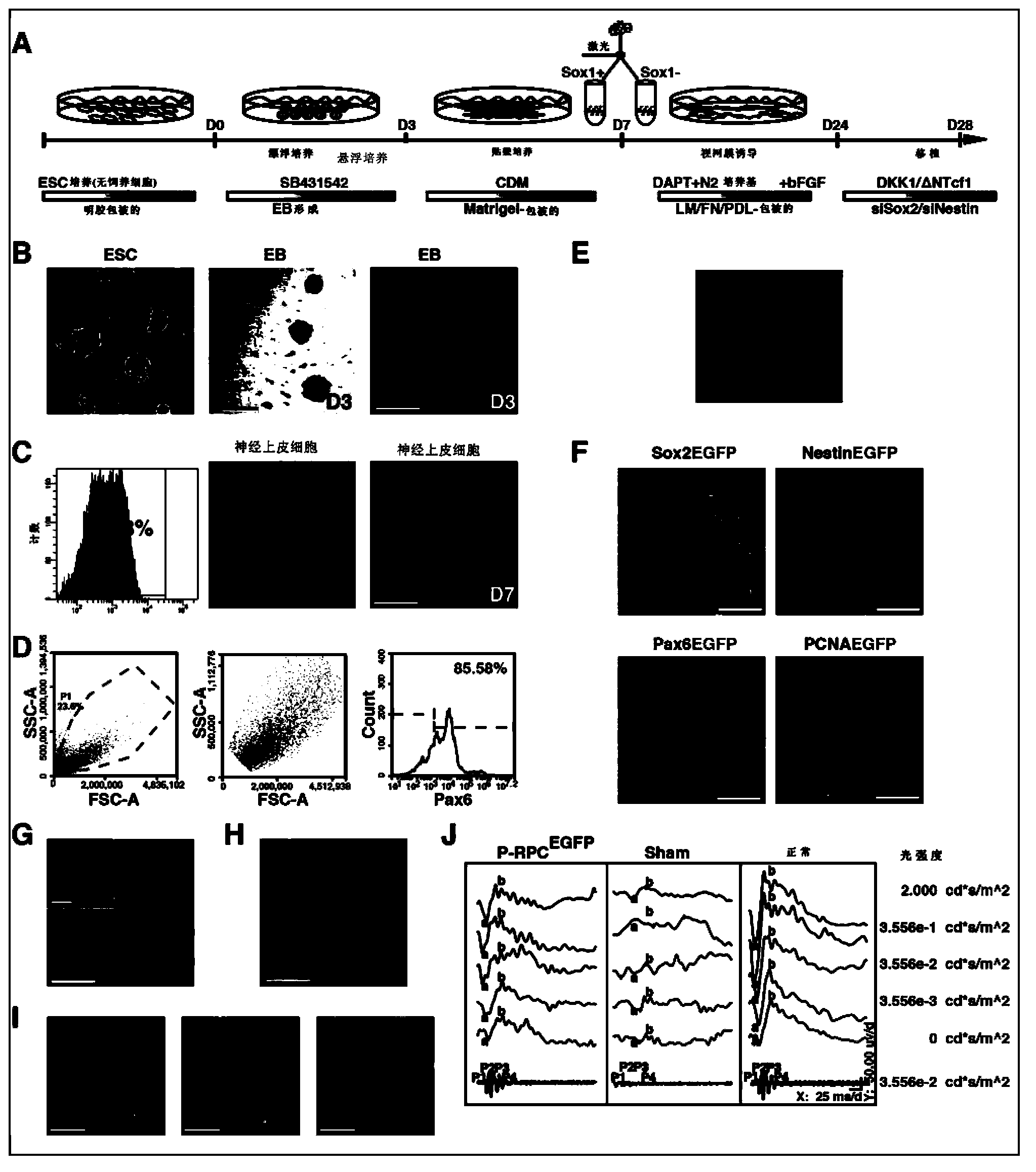Method of regulating and controlling retinal progenitor cell generated by inducing
A technology of precursor cells and retina, applied in the biological field, can solve the problems of high tumorigenicity, inability to obtain therapeutic effect, and low integration rate
- Summary
- Abstract
- Description
- Claims
- Application Information
AI Technical Summary
Problems solved by technology
Method used
Image
Examples
Embodiment 1
[0150] Example 1. Tumorogenicity of ESC-RPC and Primary RPC in Transplanted Eyes
[0151] First, the inventors differentiated mouse embryonic stem cells (ESCs) (Sox1.GFP transgenic 46C cell line) into retinal precursor cells (RPCs) using a chemically optimized SFEB-based strategy (see figure 1 A-C and "Materials and Methods Employed in the Invention" section). Based on this strategy, the Sox1.GFP that was flow-sorted on the 7th day + The neural progenitor cells were further differentiated, and ESC-RPCs were obtained on day 24. The inventors identified differentiated cells using 3 methods: Immunofluorescent staining revealed that at an early stage of differentiation (day 14), the cells expressed multiple neural progenitor cell markers, such as Nestin, Pax6 and Six3, and the retinal marker Rax ; at the terminal stage of differentiation (day 24) cells expressed the photoreceptor precursor marker Otx2, and the rod cell markers Nrl and Opsin ( figure 2 A). ESC-derived RPCs at ...
Embodiment 2
[0155] Example 2. ESC-RPC possesses characteristics of P-RPC by inhibiting canonical Wnt signaling
[0156] According to the completely different results of transplantation of ESC-RPC and P-RPC in Example 1, the inventors continued to search for the molecular network to distinguish these two different donor cells. The inventors compared the whole gene transcripts of ESC-RPC and P-RPC. For each cell type, the inventors took 3 sets of parallel samples for transcript analysis. A total of 4488 genes showed more than 2-fold difference (P image 3 A). Notably, many genes encoding Wnt pathway-related genes showed differences in expression levels ( image 3 B). Especially the canonical Wnt signaling downstream target genes (Axin2, c-Myc and cyclin D2) and the nuclear localization of β-catenin ( image 3 B and Figure 4 A) Implications that Wnt signaling is maintained at a high level in ESC-RPC. To test whether high levels of Wnt signaling are associated with high tumorigenicity a...
Embodiment 3
[0161] Example 3. Tcf1 mediates the function of canonical Wnt signaling in ESC-RPC
[0162] The inventors investigated which transcription factors mediate the function of canonical Wnt signaling in ESC-RPCs. The inventor noticed that in ESC-RPC ( Figure 5 A) and eye tumors induced by ESC-RPC injection ( Figure 5 B and Figure 6A) High expression of full-length Tcf1 (fTcf1). In addition, DKK1 treatment significantly reduced the proportion of fTCF1+ and Nestin+ cells in ESC-RPCs ( Figure 6 B). In addition, the inventors found that among all Tcf / Lef factors, Tcf1 was highly expressed in the developing mouse retina, implying its important role in retinal development ( Figure 6 C). Based on these observations and the known function of β-catenin, which normally binds Tcf / Lef factors to carry out canonical Wnt signaling, the inventors predicted that Tcf1 might play a key role in regulating the differentiation and proliferation of ESC-RPCs, although this has never been done ...
PUM
 Login to View More
Login to View More Abstract
Description
Claims
Application Information
 Login to View More
Login to View More - R&D
- Intellectual Property
- Life Sciences
- Materials
- Tech Scout
- Unparalleled Data Quality
- Higher Quality Content
- 60% Fewer Hallucinations
Browse by: Latest US Patents, China's latest patents, Technical Efficacy Thesaurus, Application Domain, Technology Topic, Popular Technical Reports.
© 2025 PatSnap. All rights reserved.Legal|Privacy policy|Modern Slavery Act Transparency Statement|Sitemap|About US| Contact US: help@patsnap.com



